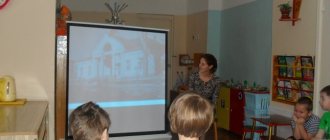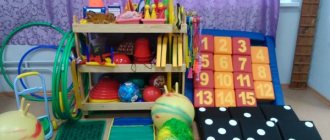Corner of role-playing games. Hospital
Yulia Tugusheva
Corner of role-playing games. Hospital
Role-playing games corner . Hospital ,
The group has created a comfortable subject-spatial environment that corresponds to the age and individual characteristics of children. The developmental environment has flexible zoning, which allows children, in accordance with their interests and desires, to freely engage in different types of activities at the same time, without interfering with each other. The areas of independent children's activity within the group do not overlap; there is enough space for children to move freely. All games and materials in the group are arranged in such a way that every child has free access to them. This organization of space allows preschoolers to choose interesting activities for themselves, alternate them during the day, and the teacher organizes the educational process taking into account the individual characteristics of the children.
The development environment of the group reflects the main directions of educational areas of the Federal State Educational Standard for Education: - cognitive development; — communicative and personal development; - speech development; — artistic and aesthetic development; - physical development.
The group room space is organized in the form of well-demarcated corners (development centers)
:
-corner for theatrical games; corner -music corner ; -book corner ; — a corner for role-playing games ; -mathematical games corner ; -a corner of nature and experimentation; -sports section ; -a corner for visual activities (drawing, modeling, appliqué, modeling)
;
- design corner ; - corner of privacy ;
Role-playing games corner , Hospital »»
The play area is equipped with attributes for role-playing games , selected taking into account the age characteristics of children. It includes: Didactic aids, visual aids, game set, Doctor, thermometer, syringe, bandage, cotton wool, pipette, phonedoscope, stadiometer, heating pads, children's honey. suit (robe and cap, bag with a cross, paper for writing down recipes + pencil.
All gaming materials and manuals are freely available to children.
Tasks:
Develop children's cognitive abilities,
To arouse in children an interest in the medical profession, to cultivate a sensitive, attentive attitude towards the patient .
To develop in children the ability to take on a role and perform appropriate game actions, to use honey during the game. tools.
Promote the emergence of role-playing dialogue.
The subject-development environment we have created allows us to ensure maximum psychological comfort for each child, create opportunities for the exercise of his right to freely choose the type of activity, the degree of participation in it, the ways of its implementation and interaction with others. This organization of the subject-spatial developmental environment of the group seems to us the most rational, since it takes into account the main directions of the child’s development and contributes to his favorable development.
When organizing a subject-spatial environment in a kindergarten, complex, multifaceted activities of all participants in the educational process are necessary. Further work involves searching for innovative approaches to organizing the subject-development environment in preschool educational institutions, as well as developing parents’ interest in this problem and motivating the desire for interaction.
Materials for the “Health Corner” stand; methodological development on the topic
Serous viral meningitis
Serous viral meningitis is the most typical and severe form of enteroviral damage to the central nervous system.
The source of infection is patients and virus carriers. Some insects (for example, ticks) can act as carriers of infection.
Symptoms: The disease begins acutely, with a rise in temperature to 38-40 degrees, severe headache, dizziness, vomiting, sometimes with pain in the abdomen, back, and convulsions.
If similar complaints appear, it is necessary to urgently isolate the patient, because it is a source of infection for others, and consult a doctor.
Considering the possible routes of transmission, personal prevention measures should consist of following the rules of personal hygiene (washing hands before each meal), maintaining a drinking regime (boiled water, bottled water), carefully processing the fruits and vegetables consumed and then rinsing them with boiling water. You should swim in specially designated areas and do not swallow water. Do not wash vegetables and fruits in open water. During an increase in incidence, you should avoid visiting public events, places with a large number of people (public transport, cinemas, etc.). We recommend wet cleaning of residential premises at least 2 times a day and ventilation of the premises.
Under no circumstances should a child with any manifestations of the disease be allowed to attend an organized children's group (school, preschool institutions).
Clinically, the disease can begin with symptoms similar clinically to an acute respiratory viral infection (sore throat, runny nose, general weakness, which is accompanied by a rise in body temperature). Therefore, if a case of illness accompanied by these symptoms appears in the family, it is necessary to isolate the patient in the apartment, allocate separate dishes, not allow children near the sick person, one of the family members should take care of him, cover his nose with a disposable tissue when coughing and sneezing (use once), carry out routine cleaning using disinfectants, and regularly ventilating the premises.
According to sanitary doctors, there are no clustered foci of enterovirus infection in the region. According to the regional department of Rospotrebnadzor, as of July 18, 38 cases of disease due to enterovirus infection were registered in the region, of which 27 cases of serous meningitis and 11 of herpangina. It is emphasized that the cases of the disease are not related to each other and no outbreaks of group morbidity have been registered. Most of the sick did not follow the rules of personal hygiene, used unboiled water for drinking, and fruits and vegetables were not treated with boiling water before consumption.
The reason for the rapid spread of infection is due to the fact that the clinical forms of enterovirus infection are varied. This is due to the large number of pathogens that can cause the disease. Enterovirus infection can occur in the form of mild forms of the disease, such as conjunctivitis, pharyngitis, gastroenteritis, three-day fever, herpangina. In more severe cases, encephalitis and serous meningitis are recorded.
At the first sign of an infectious disease, you must contact a medical facility!
YOU NEED TO REMEMBER FOREVER:
THE KEY TO HEALTH IS CLEANITY!
Practical examples
Model of a district with a hospital campus, SD3D company
Task
Source: sd3d.com
SD3D, based in San Diego, USA, was commissioned by insurance company Aon to create a 274 x 320 cm 3D model of one of the city's districts, including a hospital campus. This giant model was supposed to demonstrate the company's capabilities to shareholders.
Solution
Source: sd3d.com
Producing a detailed 3D model of this size using traditional methods would have taken too much time, so most of the parts were made using 3D printing. Two-dimensional drawings of the hospital, the surrounding area and the objects located on it were given as initial data. The SD3D team used Rhino design software to create 3D printable models. Printing something this large was no easy task. The model was divided into 23 x 23 cm squares, and all tall buildings were also cut into pieces not exceeding 23 cm in height. In total, more than 300 pieces were printed, not counting small trees, plants and small architectural forms scattered throughout.
Equipment
The 3D printing was done on more than ten FDM printers. The main load fell on the Lulzbot TAZ devices and a 3D printer of its own design. Almost everything was printed using Hatchbox White PLA, with the exception of the colored parts: roads (gray PLA), plants (green PLA), cones (red PLA). With a layer thickness of 0.4 mm, about 65 kg of filament was spent. The water was cut separately from blue acrylic.
Size
Source: sd3d.com
The layout dimensions on a plane are 2.7 x 3.2 meters.
Time
Source: sd3d.com
Creating the layout took 30 days or more than 3,000 man-hours, including 200 hours of labor time translating 2D drawings into a 3D model.
MSF Hospital Project in the Philippines
Task
Source: all3dp.com
Typhoon Haiyan swept through the Philippines on November 8, 2013, causing a disaster on an unprecedented scale for the country. Entire settlements were wiped off the face of the earth, and the storm wave claimed thousands of lives. About 16 million people lost their homes and more than 6,200 people died. The organization Doctors Without Borders was faced with the task of opening a large autonomous hospital in the shortest possible time and training doctors arriving from different parts of the world to work in it, even before they get to the scene of the disaster.
Solution
Source: all3dp.com
The MSF technical team, led by Elvina Motard, in collaboration with the additive manufacturing and virtual reality company Pyxis, quickly produced a virtual 3D model of the hospital and printed its layout on a 3D printer. This made it possible to train doctors in advance to work in the hospital and save valuable time for providing care to the Filipinos.
Equipment
Source: all3dp.com
Raise3D 3D printers of various models.
Opinion of Top 3D Shop specialists
In the photo: Teymur Aliyev, specialist in the service department of Top 3D Shop.
When making three-dimensional models of hospitals and clinics, one should take into account not only the architects' plans, but also the strict legal standards for this type of facility. In addition, when designing, you need to roughly understand where and what type of medical equipment will be used, and what requirements for the premises and utilities are set by its manufacturer.
With the help of 3D layouts, you can also visually explore the logistics component, both for ambulances or air ambulances, and for patients using public or private transport. You can read about ways to create 3D models, including medical institutions, in the article “Making a model of a school of any complexity.”










